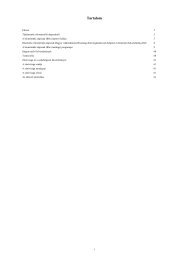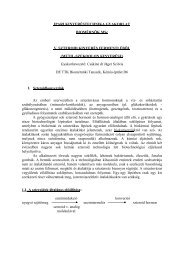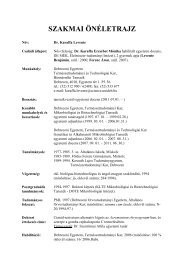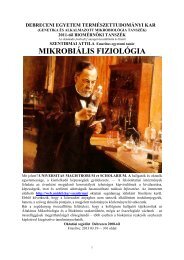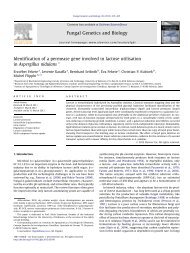Stimulation of the cyanide-resistant alternative respiratory pathway ...
Stimulation of the cyanide-resistant alternative respiratory pathway ...
Stimulation of the cyanide-resistant alternative respiratory pathway ...
You also want an ePaper? Increase the reach of your titles
YUMPU automatically turns print PDFs into web optimized ePapers that Google loves.
216<br />
<strong>Stimulation</strong> <strong>of</strong> <strong>the</strong> <strong>cyanide</strong>-<strong>resistant</strong> <strong>alternative</strong><br />
<strong>respiratory</strong> <strong>pathway</strong> by oxygen in Acremonium<br />
chrysogenum correlates with <strong>the</strong> size <strong>of</strong> <strong>the</strong><br />
intracellular peroxide pool<br />
Levente Karaffa, Erzsébet Sándor, Erzsébet Fekete, József Kozma,<br />
Attila Szentirmai, and István Pócsi<br />
Abstract: The relationship between oxygen input and activity <strong>of</strong> <strong>the</strong> <strong>cyanide</strong>-<strong>resistant</strong> <strong>alternative</strong> respiration <strong>of</strong> submerged<br />
cultures <strong>of</strong> Acremonium crysogenum was investigated. The volumetric oxygen transfer coefficient <strong>of</strong> <strong>the</strong> respective<br />
cultures correlated positively within almost two ranges <strong>of</strong> magnitude with <strong>the</strong> size <strong>of</strong> <strong>the</strong> intracellular peroxide<br />
pool, which in turn, correlated with <strong>the</strong> activity <strong>of</strong> <strong>the</strong> <strong>cyanide</strong>-<strong>resistant</strong> <strong>alternative</strong> <strong>respiratory</strong> <strong>pathway</strong>. Increased aeration<br />
also stimulated <strong>the</strong> glucose uptake rate but had no effect on <strong>the</strong> total respiration rate or <strong>the</strong> growth rate. Addition<br />
<strong>of</strong> <strong>the</strong> lipid peroxyl radical scavenger DL-α-tocopherol to A. chrysogenum cultures decreased <strong>the</strong> rate <strong>of</strong> intracellular<br />
peroxide production as well as glucose uptake. An increase in <strong>the</strong> <strong>cyanide</strong>-<strong>resistant</strong> fraction <strong>of</strong> total respiration was observed,<br />
while growth and <strong>the</strong> total <strong>respiratory</strong> activity remained unchanged. We conclude that intracellular peroxides<br />
may stimulate <strong>the</strong> <strong>alternative</strong> respiration in A. chrysogenum.<br />
Key words: Acremonium chrysogenum, <strong>alternative</strong> respiration, oxygen, peroxide, Kla.<br />
Résumé : Nous avons étudié le lien qui existe entre la consommation d’oxygène et l’activité Karaffarespiratoire et al. auxiliaire résistante<br />
au cyanure de cultures submergées de Acremonium crysogenum. Le coefficient de transfert volumétrique de<br />
l’oxygène des cultures respectives fut corrélé positivement sur près de deux ordres de grandeur avec la taille de la réserve<br />
de peroxydes intracellulaires, qui à son tour était corrélé avec l’activité de la voie respiratoire auxiliaire résistante<br />
au cyanure. Une augmentation de l’aération a également stimulé le taux d’absorption de l’oxygène, mais n’a eu aucun<br />
effet sur la vitesse respiratoire ou le taux de croissance. L’ajout de DL--tocopherol, un agent neutralisant les radicaux<br />
lipidiques peroxydés, aux cultures de A. crysogenum a réduit le taux de production de peroxydes intracellulaires de<br />
même que l’absorption de glucose. Nous avons observé une augmentation de la fraction de la respiration totale qui<br />
était résistante au cyanure, alors que la croissance et l’activité respiratoire totale demeuraient inchangées. Nous concluons<br />
que les peroxydes intracellulaires pourraient stimuler la respiration auxiliaire chez A. crysogenum.<br />
Mots clés : Acremonium crysogenum, respiration auxiliaire, oxygène, peroxyde, Kla.<br />
[Traduit par la Rédaction] 220<br />
Introduction<br />
Mitochondria <strong>of</strong> many fungi possess a <strong>cyanide</strong>-<strong>resistant</strong> <strong>alternative</strong><br />
<strong>respiratory</strong> <strong>pathway</strong> containing a characteristic<br />
<strong>alternative</strong> oxidase, which bypasses <strong>the</strong> sites <strong>of</strong> energy conservation,<br />
leading to a decrease in <strong>the</strong> energy yield <strong>of</strong> cells<br />
(Sluse and Jarmuszkiewicz 1998). Fungal <strong>alternative</strong> oxidase<br />
Received 3 December 2002. Revision received 4 March 2003.<br />
Accepted 26 March 2003. Published on <strong>the</strong> NRC Research<br />
Press Web site at http://cjm.nrc.ca on 22 April 2003.<br />
L. Karaffa, 1 E. Sándor, E. Fekete, A. Szentirmai, and I.<br />
Pócsi. Department <strong>of</strong> Microbiology and Biotechnology,<br />
Faculty <strong>of</strong> Science, University <strong>of</strong> Debrecen, H-4010, P.O.<br />
Box 63, Debrecen, Hungary.<br />
J. Kozma. Chemical Works <strong>of</strong> Gedeon Richter Ltd., H-1103,<br />
Gyömri út 19–21, Budapest, Hungary.<br />
1 Corresponding author (e-mail: karaffal@tigris.klte.hu).<br />
activity is dependent on substrate availability (i.e.,<br />
ubiquinone concentration and its redox state in <strong>the</strong> membrane<br />
and O 2 concentration in <strong>the</strong> cell) and is regulated at<br />
<strong>the</strong> level <strong>of</strong> gene expression by post-translational modification<br />
and by allosteric activation (Umbach and Siedow 2000).<br />
The production <strong>of</strong> reactive oxygen species (ROS), such as<br />
O 2 – and H 2 O 2 , is an unavoidable consequence <strong>of</strong> aerobic metabolism.<br />
In fungal mycelia, as in o<strong>the</strong>r <strong>respiratory</strong> chains,<br />
oxidases <strong>of</strong> <strong>the</strong> mitochondrial electron transport chain are<br />
major sites <strong>of</strong> ROS production. Several studies to date have<br />
demonstrated <strong>the</strong> capacity <strong>of</strong> <strong>the</strong> <strong>alternative</strong> <strong>respiratory</strong> <strong>pathway</strong><br />
to prevent <strong>the</strong> production <strong>of</strong> ROS (Wagner 1995; Millar<br />
and Day 1996; Maxwell et al. 1999; Karaffa et al. 2001).<br />
We previously reported that <strong>the</strong> <strong>alternative</strong> <strong>respiratory</strong> activity<br />
<strong>of</strong> Acremonium chrysogenum is strongly dependent on<br />
<strong>the</strong> dissolved oxygen level (Kozma and Karaffa 1996a). We<br />
also showed that <strong>the</strong> activity <strong>of</strong> this <strong>pathway</strong> is responsive to<br />
changes in <strong>the</strong> intracellular peroxide (IP) levels (Karaffa et<br />
Can. J. Microbiol. 49: 216–220 (2003) doi: 10.1139/W03-029 © 2003 NRC Canada
Karaffa et al. 217<br />
al. 2001). In this study, we will demonstrate that <strong>the</strong> effect<br />
<strong>of</strong> oxygen on <strong>the</strong> <strong>cyanide</strong>-<strong>resistant</strong> <strong>alternative</strong> <strong>respiratory</strong><br />
<strong>pathway</strong> is mediated via changes in <strong>the</strong> size <strong>of</strong> <strong>the</strong> IP pool.<br />
Materials and methods<br />
Fungal strain and cultivation conditions<br />
Acremonium chrysogenum ATCC 46117 was grown at<br />
28°C in 500-mL Erlenmeyer flasks on a NBS orbital shaker<br />
(New Brunswick Scientific Co., Inc., Edison, N.J., U.S.A.)<br />
at 200 rpm (Karaffa et al. 1999). The complete growth medium<br />
was inoculated with a 10% (v/v) 3-day-old seed culture,<br />
as detailed earlier (Kozma and Karaffa 1996a).<br />
For replacement experiments, mycelia grown for 14 h in<br />
complete medium were harvested by filtration on a sintered<br />
glass funnel, washed with cold tap water, and <strong>the</strong>n transferred<br />
into a minimal medium (Karaffa et al. 1997) with<br />
glucose as <strong>the</strong> sole carbon source. DL-α-Tocopherol was supplied<br />
to <strong>the</strong> culture media 3 h after <strong>the</strong> transferring procedure,<br />
to yield a final concentration <strong>of</strong> 0.2 mM. Samples were taken<br />
after 4h<strong>of</strong>fur<strong>the</strong>r incubation — a period that was found to<br />
be sufficient to achieve maximal mycelial respiration, including<br />
<strong>the</strong> activity <strong>of</strong> <strong>the</strong> <strong>alternative</strong> <strong>respiratory</strong> <strong>pathway</strong>.<br />
The starting mycelial dry weight was approximately 4.0 g L –1<br />
in each replacement experiment.<br />
Creation <strong>of</strong> different oxygen input in shake flasks<br />
Although <strong>the</strong> technical means to modify <strong>the</strong> oxygen transfer<br />
rate in a series <strong>of</strong> 500-mL shake flasks are limited compared<br />
with what may be obtained within a fermenter, <strong>the</strong>re<br />
are still a few methods that could result in a gradient <strong>of</strong> oxygen<br />
input. For example, varying <strong>the</strong> ratio <strong>of</strong> flask volume to<br />
medium volume can change <strong>the</strong> volumetric oxygen transfer<br />
coefficient (Kla). High volumes within flasks lower <strong>the</strong> specific<br />
oxygen transfer rate. In addition, by putting a porous<br />
cotton cap onto <strong>the</strong> flask instead <strong>of</strong> a metal cap, aeration and<br />
Kla may be increased. Finally, <strong>the</strong> presence <strong>of</strong> baffles that<br />
serve to disrupt <strong>the</strong> vortex pattern result in <strong>the</strong> production <strong>of</strong><br />
a larger liquid–air interfacial surface. The resulting turbulent<br />
flow pattern is also beneficial with respect to increasing <strong>the</strong><br />
oxygen transfer rate. The aeration-related properties <strong>of</strong> <strong>the</strong><br />
shake-flask cultures used in this study are displayed at Table<br />
1.<br />
Analytical methods<br />
Kla values <strong>of</strong> <strong>the</strong> shake flasks (characterized in Table 1)<br />
were determined by <strong>the</strong> sulphite-oxidation method (Cooper<br />
et al. 1944).<br />
Fungal growth was monitored by recording dry cell<br />
weights (DCW; Sándor et al. 2001). Specific growth rates<br />
were calculated from <strong>the</strong> increased DCW over <strong>the</strong> duration<br />
<strong>of</strong> <strong>the</strong> experiment (Pirt 1975).<br />
Glucose consumption was monitored by HPLC on a H +<br />
exchange column (Bio-Rad Aminex HPX-H + , Hercules, Calif.),<br />
as described earlier (Sándor et al. 2001).<br />
The measurement <strong>of</strong> <strong>the</strong> mycelial respiration rates, including<br />
that <strong>of</strong> <strong>the</strong> <strong>alternative</strong> <strong>respiratory</strong> <strong>pathway</strong>, was performed<br />
in an oxygraphic cell (Bahr and Bonner 1973). A 1-<br />
mM concentration <strong>of</strong> KCN was used to inhibit cytochrome<br />
oxidase <strong>of</strong> <strong>the</strong> cytochrome-dependent <strong>pathway</strong>.<br />
Table 1. Physical properties related to aeration <strong>of</strong> <strong>the</strong> shake-flask<br />
cultures used in this study.<br />
Culture<br />
No.<br />
I<br />
II<br />
III<br />
IV<br />
V<br />
IP levels were calculated by <strong>the</strong> spectr<strong>of</strong>luorimetric determination<br />
<strong>of</strong> 2′,7′-dichlor<strong>of</strong>luorescein (2′,7′-DCF) production<br />
from 2′,7′-dichlor<strong>of</strong>luorescin diacetate, as described earlier<br />
(Royall and Ischiropoulos 1993; Karaffa et al. 2001). Specific<br />
IP values are related to milligrams <strong>of</strong> protein, which<br />
was determined by means <strong>of</strong> a modified Lowry method (Peterson<br />
1983) using bovine serum albumin for calibration.<br />
Reproducibility<br />
All <strong>the</strong> data presented here are means <strong>of</strong> at least three independent<br />
experiments. The variations among experiments<br />
were estimated by standard deviations (SDs) for each procedure.<br />
The SD values were always less than 10% <strong>of</strong> <strong>the</strong><br />
means. The significance <strong>of</strong> changes as a function <strong>of</strong> Kla values<br />
was assessed using <strong>the</strong> Student’s t test, with p values<br />
cited in <strong>the</strong> text.<br />
Chemicals<br />
All chemicals were <strong>of</strong> analytical grade, and were purchased<br />
from Sigma-Aldrich Kft., Budapest, Hungary, with<br />
<strong>the</strong> exceptions <strong>of</strong> 2′,7′-dichlor<strong>of</strong>luorescin diacetate and 2′,7′-<br />
dichlor<strong>of</strong>luorescein, which were purchased from Eastport<br />
Kft., Budapest, Hungary.<br />
Results<br />
Aeration properties <strong>of</strong> <strong>the</strong><br />
500-mL shake-flask<br />
cultures<br />
30 mL <strong>of</strong> aliquots,<br />
baffled, cotton cap<br />
80 mL <strong>of</strong> aliquots,<br />
baffled, cotton cap<br />
80 mL <strong>of</strong> aliquots,<br />
unbaffled, cotton cap<br />
80 mL <strong>of</strong> aliquots,<br />
unbaffled, metal cap<br />
150 mL <strong>of</strong> aliquots,<br />
unbaffled, metal cap<br />
Volumetric oxygen<br />
transfer coefficient (Kla)<br />
value (min –1 )<br />
11.5<br />
Growth and glucose consumption<br />
Washed and transferred mycelia <strong>of</strong> A. chrysogenum<br />
quickly adapted to <strong>the</strong> new environment as indicated by <strong>the</strong><br />
glucose uptake and <strong>the</strong> subsequent biomass production rates.<br />
The growth rate <strong>of</strong> cultures with different Kla values was not<br />
significantly different (p < 0.1) during <strong>the</strong> examined period<br />
(Fig. 1A). On <strong>the</strong> contrary, glucose consumption was progressively<br />
more rapid (p < 0.1) with increasing oxygen<br />
transfer rate (Fig. 1A).<br />
Respiratory activity<br />
Despite <strong>the</strong> major differences in <strong>the</strong> respective oxygen<br />
transfer rates <strong>of</strong> cultures, <strong>the</strong> total <strong>respiratory</strong> activity<br />
seemed relatively unaffected (p < 1), very slightly decreasing<br />
with decreasing Kla values. The difference in total oxygen<br />
uptake among cultures with <strong>the</strong> highest and <strong>the</strong> lowest<br />
oxygen transfer rates was not more than 8% (Fig. 1B).<br />
7.8<br />
3.2<br />
1.0<br />
0.42<br />
© 2003 NRC Canada
218 Can. J. Microbiol. Vol. 49, 2003<br />
Fig. 1. Comparison <strong>of</strong> Acremonium chrysogenum shake-flask cultures<br />
with no DL-α-tocopherol supplementation. (A) Growth rate<br />
() and glucose uptake rate (). (B) Total <strong>respiratory</strong> activity<br />
() and <strong>cyanide</strong>-<strong>resistant</strong> fraction <strong>of</strong> <strong>the</strong> total respiration ().<br />
(C) Intracellular peroxide production (). DCW, dry cell weight;<br />
2′,7′-DCF, 2′,7′-dichlor<strong>of</strong>luorescein.<br />
Fig. 2. Comparison <strong>of</strong> Acremonium chrysogenum shake-flask cultures<br />
with 0.2 mM DL-α-tocopherol supplementation in all flasks.<br />
(A) Growth rate () and glucose uptake rate (). (B) Total <strong>respiratory</strong><br />
activity () and <strong>cyanide</strong>-<strong>resistant</strong> fraction <strong>of</strong> <strong>the</strong> total<br />
respiration (). (C) Intracellular peroxide production (). DCW,<br />
dry cell weight; 2′,7′-DCF, 2′,7′-dichlor<strong>of</strong>luorescein.<br />
In contrast, <strong>the</strong> <strong>cyanide</strong>-<strong>resistant</strong> fraction <strong>of</strong> <strong>the</strong> respiration<br />
significantly (p < 0.1) increased by increasing <strong>the</strong> oxygen<br />
transfer rate (Fig. 1B). At Kla = 11.5 min –1 , <strong>the</strong> <strong>cyanide</strong><strong>resistant</strong><br />
respiration comprised almost 40% <strong>of</strong> <strong>the</strong> total oxygen<br />
consumption as opposed to a mere 16% at Kla =<br />
0.42 min –1 .<br />
Intracellular peroxide levels<br />
Figure 1C shows that <strong>the</strong> IP levels <strong>of</strong> cultures were increasing<br />
with increasing Kla (p < 1). At <strong>the</strong> two most extreme<br />
values, IP values in mycelia growing in a shake flask<br />
were about 50% higher at Kla = 11.5 min –1 than at Kla =<br />
0.42 min –1 .<br />
Effects <strong>of</strong> DL-α-tocopherol<br />
To provide a correlation between <strong>the</strong> intensity <strong>of</strong> <strong>the</strong> <strong>alternative</strong><br />
respiration and <strong>the</strong> IP levels, <strong>the</strong> free radical scavenger<br />
DL-α-tocopherol was employed. Comparison <strong>of</strong> Figs. 1A<br />
and 2A shows that <strong>the</strong> addition <strong>of</strong> DL-α-tocopherol in <strong>the</strong><br />
medium did not influence growth rate <strong>of</strong> any <strong>of</strong> <strong>the</strong> examined<br />
cultures (p < 0.1), but it decreased <strong>the</strong> glucose uptake<br />
rate by up to 18–25%. DL-α-Tocopherol also affected both<br />
<strong>the</strong> <strong>alternative</strong> respiration (compare Figs. 1B and 2B) and<br />
<strong>the</strong> IP levels (compare Figs. 1C and 2C), irrespective <strong>of</strong> <strong>the</strong><br />
actual aeration <strong>of</strong> <strong>the</strong> culture. DL-α-Tocopherol effectively<br />
(p < 0.1) decreased <strong>the</strong> IP concentration generated by <strong>the</strong><br />
oxygen input and also decreased <strong>the</strong> activity <strong>of</strong> <strong>the</strong> <strong>alternative</strong><br />
<strong>respiratory</strong> <strong>pathway</strong>. When DL-α-tocopherol was added<br />
to <strong>the</strong> culture with <strong>the</strong> lowest Kla value, IP levels declined<br />
until <strong>the</strong>y went down below <strong>the</strong> lower limit <strong>of</strong> sensitivity <strong>of</strong><br />
<strong>the</strong> 2′,7′-DCF method. At <strong>the</strong> same time, <strong>cyanide</strong>-<strong>resistant</strong><br />
respiration also decreased until almost to its detection limit.<br />
All <strong>the</strong>se data indicate that manipulation <strong>of</strong> <strong>the</strong> IP concentration<br />
modulates <strong>the</strong> activity <strong>of</strong> <strong>the</strong> <strong>alternative</strong> <strong>respiratory</strong><br />
<strong>pathway</strong>. Noteworthily, <strong>the</strong> total respiration rate <strong>of</strong> <strong>the</strong> cultures<br />
was not affected (p < 0.1) by <strong>the</strong> presence <strong>of</strong> DL-αtocopherol<br />
(Fig. 2B).<br />
Discussion<br />
The present study implies that <strong>the</strong> requirement <strong>of</strong> oxygen<br />
for growth or <strong>respiratory</strong> activity is not particularly high in<br />
© 2003 NRC Canada
Karaffa et al. 219<br />
A. chrysogenum — in <strong>the</strong> range <strong>of</strong> <strong>the</strong> oxygen transfer rates<br />
studied (defined by <strong>the</strong> Kla value <strong>of</strong> <strong>the</strong> respective shake<br />
flasks), growth was not limited by <strong>the</strong> oxygen. Roughly<br />
similar specific growth rates were measured in each <strong>of</strong> <strong>the</strong><br />
cultures, including Culture No. I with Kla = 11.5 min –1 , corresponding<br />
to ca. 30% <strong>of</strong> saturation <strong>of</strong> dissolved oxygen<br />
(Kozma and Karaffa 1996b). A constant rate <strong>of</strong> biomass production<br />
was sustained by a practically unchanged total <strong>respiratory</strong><br />
activity, rendering all <strong>the</strong> five cultures apparently similar.<br />
However, several o<strong>the</strong>r parameters <strong>of</strong> <strong>the</strong> cultures were Kla<br />
dependent. Glucose consumption increased with increased<br />
aeration. This could well be explained by <strong>the</strong> enhanced activity<br />
<strong>of</strong> <strong>the</strong> nonphosphorylating <strong>alternative</strong> <strong>respiratory</strong> <strong>pathway</strong>,<br />
which is able to sink significant amounts <strong>of</strong> carbon without<br />
ATP production (Lambers 1982). The high oxygen requirement<br />
(ca. 30% <strong>of</strong> saturation) <strong>of</strong> <strong>the</strong> fungal <strong>alternative</strong> <strong>respiratory</strong><br />
<strong>pathway</strong> compared with <strong>the</strong> cytochrome-dependent route<br />
is well documented (Kubicek et al. 1980; Kozma and Karaffa<br />
1996a). As a consequence <strong>of</strong> <strong>the</strong> enhanced <strong>alternative</strong> <strong>respiratory</strong><br />
activity, more glucose had to be catabolized to restore <strong>the</strong><br />
necessary ATP yield.<br />
Glucose uptake data are in good agreement with those obtained<br />
by <strong>the</strong> addition <strong>of</strong> exogenous H 2 O 2 to A. chrysogenum<br />
cultures, <strong>the</strong>reby, stimulating <strong>the</strong> <strong>alternative</strong> <strong>respiratory</strong> route<br />
(Karaffa et al. 2001). None<strong>the</strong>less, biomass production <strong>of</strong><br />
<strong>the</strong> cultures was not steady in those experiments, but transiently<br />
decreased when H 2 O 2 concentration was above<br />
100 mM. An explanation for this contradiction might be that<br />
<strong>the</strong> presence <strong>of</strong> H 2 O 2 in such high concentrations increased<br />
<strong>the</strong> <strong>alternative</strong> <strong>respiratory</strong> activity beyond <strong>the</strong> level that<br />
could still be balanced by <strong>the</strong> cytochrome-dependent, ATPgenerating,<br />
and <strong>the</strong>refore, growth-supporting <strong>respiratory</strong> <strong>pathway</strong>.<br />
In this study, that limit was obviously not reached. Indeed,<br />
<strong>the</strong> highest level <strong>of</strong> <strong>the</strong> <strong>cyanide</strong>-<strong>resistant</strong> <strong>respiratory</strong><br />
activity achieved by <strong>the</strong> increased oxygen transfer rates was<br />
less than 40% <strong>of</strong> <strong>the</strong> total respiration, in contrast to <strong>the</strong> effect<br />
<strong>of</strong> 200 mM H 2 O 2 , which resulted in a <strong>cyanide</strong>-<strong>resistant</strong><br />
fraction comprising more than 70% <strong>of</strong> <strong>the</strong> total respiration<br />
(Karaffa et al. 2001).<br />
The IP level <strong>of</strong> mycelia proved to be yet ano<strong>the</strong>r responsive<br />
parameter to aeration, even if its increase caused by <strong>the</strong><br />
higher oxygen input could be counteracted by <strong>the</strong> presence<br />
<strong>of</strong> <strong>the</strong> lipid peroxyl radical scavenger DL-α-tocopherol and<br />
vice versa (Kanno et al. 1996). As obvious as this relationship<br />
may seem, no such correlation has ever been previously<br />
reported. In turn, <strong>the</strong> activity <strong>of</strong> <strong>the</strong> <strong>alternative</strong> <strong>respiratory</strong><br />
<strong>pathway</strong> correlated with <strong>the</strong> IP concentrations under all cultivation<br />
conditions.<br />
Since a lipid peroxyl radical scavenger could effectively<br />
hinder <strong>the</strong> IP production, an overwhelming majority <strong>of</strong> <strong>the</strong><br />
molecules measured by <strong>the</strong> 2′,7′-DCF method should be <strong>of</strong><br />
lipophylic character. Since <strong>the</strong> primarily produced ROS are<br />
water-soluble, this can be only explained by a secondary,<br />
tertiary, etc., production <strong>of</strong> peroxides due to <strong>the</strong> propagation<br />
<strong>of</strong> lipid peroxidation by peroxyl radicals (Halliwell and<br />
Gutteridge 1998; Karaffa et al. 2001).<br />
It has widely been suggested by several authors that <strong>the</strong><br />
noncoupled <strong>alternative</strong> <strong>respiratory</strong> <strong>pathway</strong> contributes to<br />
<strong>the</strong> prevention <strong>of</strong> <strong>the</strong> generation <strong>of</strong> ROS (Wagner 1995;<br />
Popov et al. 1997; Maxwell et al. 1999; Umbach and Siedow<br />
2000) and that it can be considered as an integral part <strong>of</strong> <strong>the</strong><br />
antioxidant defense system in eucaryotes, including fungi.<br />
ROS are formed when <strong>the</strong> cytochrome path is impaired and<br />
(or) <strong>the</strong> intracellular oxygen is in excess. In case <strong>the</strong> available<br />
capacity <strong>of</strong> <strong>the</strong> <strong>alternative</strong> <strong>respiratory</strong> <strong>pathway</strong> is not<br />
sufficient, ROS induce <strong>the</strong> expression <strong>of</strong> <strong>the</strong> <strong>alternative</strong><br />
oxidase protein, which is similar to <strong>the</strong> H 2 O 2 -mediated expression<br />
<strong>of</strong> <strong>the</strong> plant-pathogenesis-related proteins (Chen et<br />
al. 1993).<br />
In summary, our data are in compliance with <strong>the</strong> current<br />
understanding <strong>of</strong> <strong>the</strong> nature <strong>of</strong> <strong>the</strong> <strong>cyanide</strong>-<strong>resistant</strong> <strong>alternative</strong><br />
oxidase. Moreover, a well-known feature <strong>of</strong> this route,<br />
e.g., its high oxygen requirement, was also integrated into<br />
<strong>the</strong> most accepted model <strong>of</strong> its regulation.<br />
Acknowledgements<br />
We thank Pr<strong>of</strong>essor Christian P. Kubicek (Section Microbial<br />
Biochemistry and Gene Technology, Institute <strong>of</strong> Chemical<br />
Engineering, TU Wien, Austria) for critically reading <strong>the</strong><br />
manuscript. The project was aided by grants from <strong>the</strong> Hungarian<br />
Scientific Research Fund (OTKA F 031985 and F<br />
042602) and from <strong>the</strong> Fund for Research and Development<br />
in Higher Education (FKFP 0009/2001). Erzsébet Sándor is<br />
a recipient <strong>of</strong> an OTKA Postdoctoral Fellowship (D 37975).<br />
References<br />
Bahr, J.T., and Bonner, W.D., Jr. 1973. Cyanide-insensitive respiration<br />
II. Control <strong>of</strong> <strong>the</strong> alternate <strong>pathway</strong>. J. Biol. Chem. 248:<br />
3446–3450.<br />
Chen, Z., Silva, H., and Klessig, D.F. 1993. Active oxygen species<br />
in <strong>the</strong> induction <strong>of</strong> plant systemic acquired resistance by salicylic<br />
acid. Science (Washington, D.C.), 262: 1883–1886.<br />
Cooper, C.M., Fenström, G.A., and Miller, S.A. 1944. Performance<br />
<strong>of</strong> agitated gas–liquid contractors. Ind. Eng. Chem. 36: 504–<br />
509.<br />
Halliwell, B., and Gutteridge, J.M.C. 1998. Free radicals in biology<br />
and medicine. 3rd ed. Oxford Science Publications, Oxford,<br />
U.K.<br />
Kanno, T., Utsumi, T., Takehara, Y., Ide, A., Akiyama, J., Yoshioka,<br />
T., Horton, A.A., and Utsumi, K. 1996. Inhibition <strong>of</strong> neutrophilsuperoxide<br />
generation by α-tocopherol and coenzyme Q. Free<br />
Radical Res. 24: 281–289.<br />
Karaffa, L., Sándor, E., Kozma, J., and Szentirmai, A. 1997.<br />
Methionine enhances sugar consumption, fragmentation, vacuolation<br />
and cephalosporin C production in Acremonium chrysogenum.<br />
Process Biochem. 32: 495–499.<br />
Karaffa, L., Sándor, E., Kozma, J., Kubicek, C.P., and Szentirmai,<br />
A. 1999. The role <strong>of</strong> <strong>the</strong> <strong>alternative</strong> <strong>respiratory</strong> <strong>pathway</strong> in <strong>the</strong><br />
stimulation <strong>of</strong> cephalosporin C formation by soybean oil in<br />
Acremonium chrysogenum. Appl. Microbiol. Biotechnol. 51:<br />
633–638.<br />
Karaffa, L., Váczy, K., Sándor, E., Biró, S., Szentirmai, A., and<br />
Pócsi, I. 2001. Cyanide-<strong>resistant</strong> <strong>alternative</strong> respiration is strictly<br />
correlated to intracellular peroxide levels in Acremonium<br />
chrysogenum. Free Radical Res. 34: 405–416.<br />
Kozma, J., and Karaffa, L. 1996a. Effect <strong>of</strong> oxygen on <strong>the</strong> <strong>respiratory</strong><br />
system and cephalosporin C production in Acremonium<br />
chrysogenum. J. Biotechnol. 48: 59–66.<br />
Kozma, J., and Karaffa, L. 1996b. Estimation <strong>of</strong> dissolved oxygen<br />
in shake-flask. Hung. J. Ind. Chem. 24: 225–227.<br />
Kubicek, C.P., Zehentgruber, O., El-Kalak, H., and Röhr, M. 1980.<br />
Regulation <strong>of</strong> citric acid production by oxygen: effects <strong>of</strong> dis-<br />
© 2003 NRC Canada
220 Can. J. Microbiol. Vol. 49, 2003<br />
solved oxygen tension on adenylate levels and respiration in<br />
Aspergillus niger. Eur. J. Appl. Microbiol. Biotechnol. 9: 101–<br />
116.<br />
Lambers, H. 1982. Cyanide-<strong>resistant</strong> respiration: a non-phosphorylating<br />
electron transport <strong>pathway</strong> acting as an energy overflow. Physiol.<br />
Plant. 55: 478–485.<br />
Maxwell, D.P., Wang, Y., and McIntosh, L. 1999. The <strong>alternative</strong><br />
oxidase lowers mitochondrial reactive oxygen production in<br />
plant cells. Proc. Natl. Acad. Sci. U.S.A. 96: 8271–8276.<br />
Millar, A.H., and Day, D.A. 1996. Nitric oxide inhibits <strong>the</strong><br />
cytochrome oxidase but not <strong>the</strong> <strong>alternative</strong> oxidase <strong>of</strong> plant mitochondria.<br />
FEBS Lett. 398: 155–158.<br />
Peterson, G.L. 1983. Determination <strong>of</strong> total protein. Methods<br />
Enzymol. 91: 86–105.<br />
Pirt, S.J. 1975. Principles <strong>of</strong> microbe and cell cultivation.<br />
Blackwell Scientific Publications, Oxford, U.K. pp. 156–170.<br />
Popov, V.N., Simonian, R.A., Skulachev, V.P., and Starkov, A.A.<br />
1997. Inhibition <strong>of</strong> <strong>the</strong> <strong>alternative</strong> oxidase stimulates H 2 O 2 production<br />
in plant mitochondria. FEBS Lett. 415: 87–90.<br />
Royall, J.A., and Ischiropoulos, H. 1993. Evaluation <strong>of</strong> 2,7-<br />
dichlor<strong>of</strong>luorescin and dihydrorhodamine 123 as fluorescent<br />
probes for intracellular H 2 O 2 in cultured endo<strong>the</strong>lial cells. Arch.<br />
Biochem. Biophys. 302: 348–355.<br />
Sándor, E., Szentirmai, A., Paul, G.C., Thomas, C.R., Pócsi, I., and<br />
Karaffa, L. 2001. Analysis <strong>of</strong> <strong>the</strong> relationship between growth,<br />
cephalosporin C production and fragmentation in Acremonium<br />
chrysogenum. Can. J. Microbiol. 47: 801–806.<br />
Sluse, F.E., and Jarmuszkiewicz, W. 1998. Alternative oxidase in<br />
<strong>the</strong> branched mitochondrial <strong>respiratory</strong> network: an overview on<br />
structure, function, regulation and role. Braz. J. Med. Biol. Res.<br />
31: 733–747.<br />
Umbach, A.L., and Siedow, J.N. 2000. The <strong>cyanide</strong>-<strong>resistant</strong> <strong>alternative</strong><br />
oxidase from <strong>the</strong> fungi Pichia stipitis and Neurospora<br />
crassa are monomeric and lack regulatory features <strong>of</strong> <strong>the</strong> plant<br />
enzyme. Arch. Biochem. Biophys. 378: 234–245.<br />
Wagner, A. 1995. A role for active oxygen species as second messengers<br />
in <strong>the</strong> induction <strong>of</strong> <strong>alternative</strong> oxidase gene expression<br />
in Petunia hybrida cells. FEBS Lett. 368: 339–342.<br />
© 2003 NRC Canada



